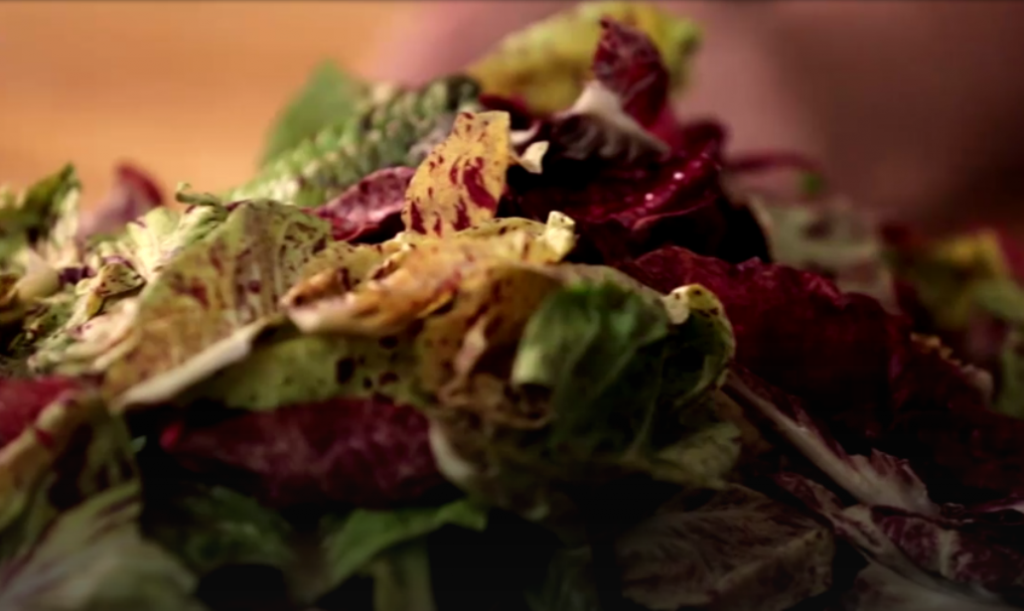 Today, we are looking at seasonable “bitter salads” and “bitter vegetables” which do not often get served at mealtimes as their taste can take some getting used to. Nevertheless, they offer many positive health benefits and include chicorée, endives, radicchio, ‘Teufelsohr’ lettuce and plenty more. Many bitter compounds are also contained in vegetables such as artichokes, Swiss chard, Brussel sprouts and rocket. Although winter salad leaves were given their TV debut on 28th Jan. in the BR-feature “Max Schmidt and winter vegetables”, in today’s blog we would like to raise the profile of varieties which, in some cases, not many people are familiar with.
Today, we are looking at seasonable “bitter salads” and “bitter vegetables” which do not often get served at mealtimes as their taste can take some getting used to. Nevertheless, they offer many positive health benefits and include chicorée, endives, radicchio, ‘Teufelsohr’ lettuce and plenty more. Many bitter compounds are also contained in vegetables such as artichokes, Swiss chard, Brussel sprouts and rocket. Although winter salad leaves were given their TV debut on 28th Jan. in the BR-feature “Max Schmidt and winter vegetables”, in today’s blog we would like to raise the profile of varieties which, in some cases, not many people are familiar with.
 Bitter compounds refer to all substances which have a bitter taste. From a chemistry perspective they do not form one uniform group as they are found in glycosides, isoprenoid, as well as alkoloids [1]. They are classified as secondary plant substances. The original use of bitter compounds is to protect plants against pests that feed on them. In actual fact, many naturally occurring bitter compounds are poisonous. Over the course of evolution the ability to recognise bitter tastes was important to survival [2]. Anyone unable to taste bitter substances was at a disadvantage in choosing what was edible. This is why the majority of people react very strongly to even low concentrations of bitter compounds.
Bitter compounds refer to all substances which have a bitter taste. From a chemistry perspective they do not form one uniform group as they are found in glycosides, isoprenoid, as well as alkoloids [1]. They are classified as secondary plant substances. The original use of bitter compounds is to protect plants against pests that feed on them. In actual fact, many naturally occurring bitter compounds are poisonous. Over the course of evolution the ability to recognise bitter tastes was important to survival [2]. Anyone unable to taste bitter substances was at a disadvantage in choosing what was edible. This is why the majority of people react very strongly to even low concentrations of bitter compounds.
Health and nutrition
 The positive impact of bitter substances on the digestive system and metabolism, however, were discovered a long time ago. The abbess and polymath Hildegard von Bingen (1098 to 1179) used natural bitter compounds and native bitter herbs to stimulate and regulate digestion. The doctor and philosopher Paracelsus (16th century, “Death is found in the intestines”), created an elixir made of myrrh, aloe and saffron which also contained various bitter roots and was said to be good for the bowel. This formula forms the basis for a medicinal drink which is known as “Swedish bitters” [4].
The positive impact of bitter substances on the digestive system and metabolism, however, were discovered a long time ago. The abbess and polymath Hildegard von Bingen (1098 to 1179) used natural bitter compounds and native bitter herbs to stimulate and regulate digestion. The doctor and philosopher Paracelsus (16th century, “Death is found in the intestines”), created an elixir made of myrrh, aloe and saffron which also contained various bitter roots and was said to be good for the bowel. This formula forms the basis for a medicinal drink which is known as “Swedish bitters” [4].
Meanwhile, it has been shown that bitter compounds positively influence digestion and the metabolism by stimulating the excretion of gastric juices and bile, for example. This promotes the digestion of fats as well as peristalsis, and stimulates the appetite [1].
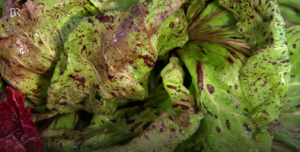 According to recent investigations, bitter receptors are also located outside of the mouth – in the gastrointestinal tract, the respiratory tract, the brain and in the pancreas [5]. The receptors in the respiratory tract can recognise bacteria and stimulate the immune system [5]. In the gastrointestinal tract an immune response can be triggered via the bitter receptors which fight against the pathogenic germs and parasites, and also improves the microbiota [6]. Bitter receptors also have an impact in the digestive tract on the release of gastrointestinal hormones and therefore positively influence the metabolism [6].
According to recent investigations, bitter receptors are also located outside of the mouth – in the gastrointestinal tract, the respiratory tract, the brain and in the pancreas [5]. The receptors in the respiratory tract can recognise bacteria and stimulate the immune system [5]. In the gastrointestinal tract an immune response can be triggered via the bitter receptors which fight against the pathogenic germs and parasites, and also improves the microbiota [6]. Bitter receptors also have an impact in the digestive tract on the release of gastrointestinal hormones and therefore positively influence the metabolism [6].
In the kitchen:
 A fundamental recommendation is to eat vegetables which are in season. But where does this leave us in winter? A diet comprised only of cabbage? This is simply not the case! In winter, numerous delicious salad varieties are available: “cichorium” plants such as chicory, radiccio, puntarelle and winter chicory, and also winter endives as well as romaine lettuces such as ‘Forellenschluss’ and ‘Teufelsohr’. These aromatic lettuces contain many bitter compounds. Endives, for example, gain their pleasant bitter, herby taste from the bitter constituent lactucopricin (intybin). “Cichorium” plants also contain lactucin and cichoriin.
A fundamental recommendation is to eat vegetables which are in season. But where does this leave us in winter? A diet comprised only of cabbage? This is simply not the case! In winter, numerous delicious salad varieties are available: “cichorium” plants such as chicory, radiccio, puntarelle and winter chicory, and also winter endives as well as romaine lettuces such as ‘Forellenschluss’ and ‘Teufelsohr’. These aromatic lettuces contain many bitter compounds. Endives, for example, gain their pleasant bitter, herby taste from the bitter constituent lactucopricin (intybin). “Cichorium” plants also contain lactucin and cichoriin.
The salad varieties listed here not only taste good but also add some variety and diversity to winter cuisine. They complement other lettuce varieties really well with their slightly bitter taste. Red radicchio or the speckled ‘Forellenschluss’, for example, add touches of colour to salads.
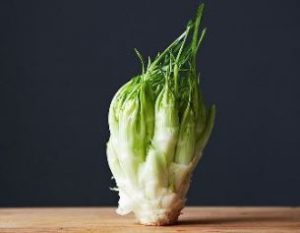
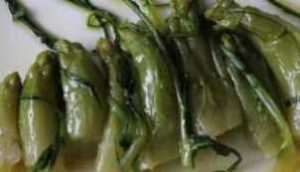 If you are someone who reacts very strongly to bitter compounds, it is recommended to soak the bitter salad leaves in luke warm water. In Germany, winter lettuces – if known of at all – are usually only regarded as something to be eaten raw. In Italy, by contrast, they are used in many more ways such as in a radicchio risotto or grilled lettuce hearts. Regarding puntarelle lettuce, it is not only the green that can be used but the young, internal tips can also be eaten raw or fried in olive oil.
If you are someone who reacts very strongly to bitter compounds, it is recommended to soak the bitter salad leaves in luke warm water. In Germany, winter lettuces – if known of at all – are usually only regarded as something to be eaten raw. In Italy, by contrast, they are used in many more ways such as in a radicchio risotto or grilled lettuce hearts. Regarding puntarelle lettuce, it is not only the green that can be used but the young, internal tips can also be eaten raw or fried in olive oil.

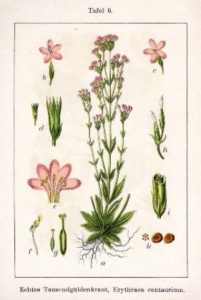 In addition to the bitter salad varieties mentioned here, there are also types of vegetables, herbs and spices which contain bitter compounds. These are also incredibly valuable for cancer patients. Their digestion-promoting effect can be used in tea or tea blends, and these also stimulate the appetite. A possible recipe for an appetite stimulating blend would be: 10g each of centaury, gentian root, liquorice root and rosemary leaves. Pour 250ml of boiling water over a teaspoon of this blend, cover and seep for seven minutes, strain and drink half an hour before eating [7].
In addition to the bitter salad varieties mentioned here, there are also types of vegetables, herbs and spices which contain bitter compounds. These are also incredibly valuable for cancer patients. Their digestion-promoting effect can be used in tea or tea blends, and these also stimulate the appetite. A possible recipe for an appetite stimulating blend would be: 10g each of centaury, gentian root, liquorice root and rosemary leaves. Pour 250ml of boiling water over a teaspoon of this blend, cover and seep for seven minutes, strain and drink half an hour before eating [7].
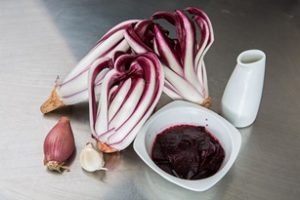 Perhaps we have been able to convince a number of you with this blog that it is well worth including these lettuce varieties in your menus more often, especially now in winter. If we have, you can look forward to next Monday as well when we will be posting a recipe perfectly suited to this topic – created, of course, by our famous star chefs exclusively for the Munich Tumour Centre.
Perhaps we have been able to convince a number of you with this blog that it is well worth including these lettuce varieties in your menus more often, especially now in winter. If we have, you can look forward to next Monday as well when we will be posting a recipe perfectly suited to this topic – created, of course, by our famous star chefs exclusively for the Munich Tumour Centre.
Quellen:
[1] „Chemie.de,“ [Online]. Available: http://www.chemie.de/lexikon/Bitterstoff.html. [Zugriff am 24 Jan 2018].
[2] Behrens M, Meyerhof M,„Bitter taste receptors and human bitter taste perception,“ Cell Mol Life Sci., Jul 2006, 63 (13): pp. 1501-9.
[3] Loper HB et al., „Taste perception, associated hormonal modulation, and nutrient intake,“ Nutr Rev., Feb 2015, 73(2): pp. 83-91.
[4] Sanatheke Medicapro Medizintechnische Produkte GmbH, „Schwedenbitter.de,“ [Online]. Available: http://www.schwedenbitter.de/. [Zugriff am 25 Jan 2018].
[5] Carey RM et al., „Taste Receptors in Upper Airway Immunity,“ Adv Otorhinolaryngol., 28 Jul 2016, 79: pp. 91-102.
[6] Shaik FA et al., „Bitter taste receptors: Extraoral roles in pathophysiology.,“ Int J biochem Cell Biol., Aug 2016, 77: pp. 197-204.
[7] Redaktion forum-naturheilkunde.de, „forum-naturheilkunde.de,“ TerraNova, [Online]. Available: https://www.forum-naturheilkunde.de/phytotherapie/amara-bitterstoffe-in-der-phytotherapie.html. [Zugriff am 25 Jan 2018].
